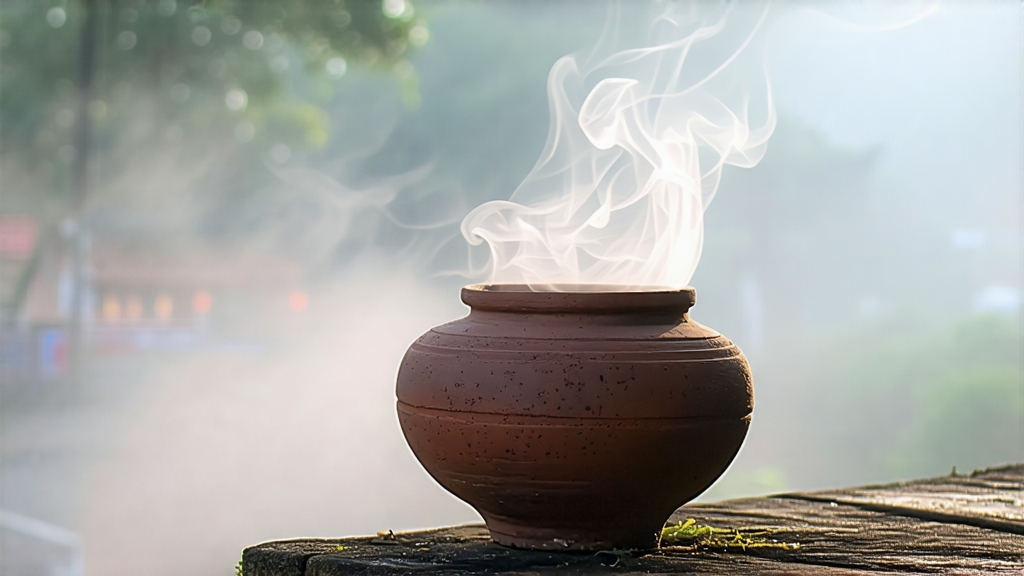
Liu Bao, pronounced “lee-ow bao,” is the quietest celebrity in the dark-tea galaxy. While Pu-erh grabs headlines and price records, Liu Bao has spent four centuries maturing in bamboo baskets, absorbing the humid breath of Guangxi’s sub-tropical mountains and the sweat of the porters who once carried it along the Tea-Horse Road. To meet Liu Bao is to taste history in motion: every leaf carries the imprint of migratory microbes, river fog, and the slow patience of farmers who still speak the Pinghua dialect.
1. Origins: From Border Town to Imperial Tribute
The name simply means “six forts,” referring to the six stockades that once protected the small trading post of Cangwu County, Wuzhou. During the Ming Jiajing era (1522–1566), soldiers arriving from Hunan found the local wild tea too astringent for their palate. They devised a piling method borrowed from Yunnan’s newly minted shou Pu-erh, but replaced Yunnan’s pine-fire drying with the natural steam of Guangxi’s caves. By the Qing Yongzheng reign (1723–1735), Liu Bao had become one of the “Three Famous Black Tributes” alongside Pu-erh and Anhua Dark Tea, shipped north to the Manchu court via the Xunjiang River and the Grand Canal.
2. Terroir: Where Rivers Breathe Through Leaves
Guangxi’s karst peaks create a giant sponge: daytime heat pushes moist air upward, nighttime coolness pulls it back down, forming a 24-hour “breathing” cycle. The soil is a reddish latosol rich in kaolin, which releases aluminum ions that soften tannic edges during fermentation. Two cultivars dominate: the small-leaf “Ling Yun Bai Hao” prized for its honey base, and the broad-leaf “Wuzhou Da Ye” that supplies the gutsy body demanded by dock workers. Picking starts after Qingming when leaves have grown to the size of a sparrow’s tongue, yet still carry the downy white hairs that will turn into golden “flowers” (Eurotium cristatum) during storage.
3. Craft: The Eight-Step Spiral
Unlike Pu-erh’s wo-dui (piling) that lasts 45 days, Liu Bao’s “double fermentation” can take up to a year, orchestrated by eight sequential steps:
- Kill-green in a dragon kiln – 280 °C for 90 seconds locks in a maillard-prone substrate.
- Rolling under hemp shoes – bare-foot rolling bruises cells without rupturing veins, preparing highways for microbes.
- First sun-dry – leaves are spread on bamboo mats tilted 15° toward the west so afternoon sun polishes the rim.
- Moisture regain – night dew is allowed to rehydrate leaves to 18 %, the sweet spot for actinomycetes.
- Basket piling – 45 kg batches are stacked inside 1 m tall bamboo cylinders lined with banana leaves; the bamboo’s natural lactobacilli inoculate the pile.
- Turning the womb – every ten days the pile is flipped, sprinkling mountain spring water infused with pomelo peel to feed yeasts.
- Second drying – a gentle 50 °C cave-wind dry for three days halts fermentation at 12 % moisture, preserving enzymatic potential for decades.
- Basket compression – semi-dry leaves are tamped back into the same bamboo shells, tied with rattan, and left to travel.
The result is a leaf that looks like burnt parchment yet smells of dried longan and camphor.
4. Aging: The Living Archive
Liu Bao is the only dark tea traditionally aged while still inside its transport basket. As caravans moved along the Pearl River system, swings in humidity and temperature orchestrated a second, unintentional fermentation. Modern collectors replicate this by storing baskets in underground wine cellars at 26 °C and 78 % RH, turning them quarterly. After ten years the Eurotium bloom forms golden stars on the leaf surface, imparting a betel-nut aroma prized by Hong Kong tea connoisseurs. Thirty-year Liu Bao acquires a ruby-black liquor and the elusive “ginseng bottom” note, a cooling sweetness